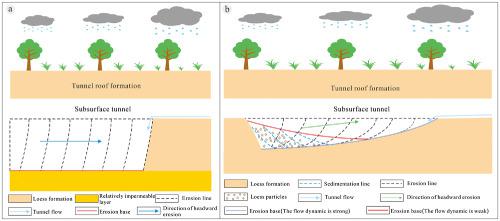当前位置:
X-MOL 学术
›
Earth Surf.Process. Land.
›
论文详情
Our official English website, www.x-mol.net, welcomes your
feedback! (Note: you will need to create a separate account there.)
Erosion characteristics of loess tunnels on the Loess Plateau: A field investigation and experimental study
Earth Surface Processes and Landforms ( IF 2.8 ) Pub Date : 2020-03-28 , DOI: 10.1002/esp.4857 Xi‐An Li 1 , Li Wang 1 , Bo Hong 1 , Lin‐Cui Li 1 , Jia Liu 1 , Hao‐nan Lei 1
Earth Surface Processes and Landforms ( IF 2.8 ) Pub Date : 2020-03-28 , DOI: 10.1002/esp.4857 Xi‐An Li 1 , Li Wang 1 , Bo Hong 1 , Lin‐Cui Li 1 , Jia Liu 1 , Hao‐nan Lei 1
Affiliation

|
Loess tunnels are a common geo‐hazard in the Loess Plateau and not only cause considerable soil and water loss, but also aggravate and even induce the occurrence and development of other disasters such as ground fissures, mudflows, collapses, and landslides. To date, research on the hydrological characteristics and erosion behaviour of loess tunnel systems has focused on field investigation data and limited river basin observation data, whereas field test information and data are very scarce. In this study, field surveys, observations, field scouring experiments, and laboratory‐based sediment percentage tests were conducted to analyse the erosion characteristics, spatial distribution, and hydrological characteristics of a large‐scale loess tunnel system in the hilly Loess Plateau southeast region of northern China. The results showed that the loess tunnel erosion exhibited periodicity. Tunnel erosion in each period shows a similar erosion process, that is, thin‐layer water flow erosion and lateral expansion, tunnel wall collapse and deposit due to the loss of support from the lateral erosion, and erosion and transport of deposits by water flow. Waterfall erosion, lateral erosion, headward erosion, and the resulting collapses were the main forms of tunnel erosion. Besides this, the base level of erosion significantly affects the erosion characteristics of the loess tunnel. The hydrological characteristics during field scouring experiments exhibited three different stages: a lag effect, attributed to the temporary loss of water velocity in the first stage; small water flow fluctuations in the second stage; and an increase in total seepage loss with increased water injection flow in the third stage. The erosion rate was positively correlated with the flow quantity. The results of this study not only provide valuable reference data for research on the mechanism and velocity of erosion events in loess, but also provide a theoretical basis for the prevention of loess tunnel disasters in engineering construction. © 2020 John Wiley & Sons, Ltd.
更新日期:2020-03-28











































 京公网安备 11010802027423号
京公网安备 11010802027423号